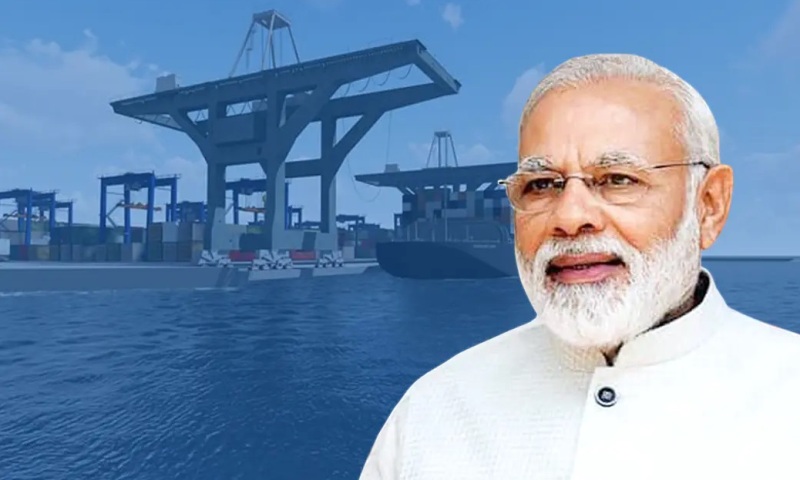Government launches largest maritime investment since Independence to strengthen shipbuilding, ports, and global competitiveness.

New Delhi : Thursday, September 25, 2025
In a historic move to boost the shipbuilding industry in India, the Central Government has announced a massive ₹70,000 crore maritime package, the largest investment in the sector since Independence. The initiative is designed to reduce India’s dependence on foreign-built vessels, improve global competitiveness, and make India a strong contender in the international shipbuilding arena.
Union Minister for Ports, Shipping, and Waterways Sarbananda Sonowal unveiled the plan, emphasizing that the government’s mission is to align India’s growth with the emerging opportunities in the global shipbuilding ranking. “This is a transformative step to ensure maritime self-reliance in India and unlock the immense potential of our coastal economy,” Sonowal declared.
Why Shipbuilding in India Matters
The shipbuilding industry in India has historically lagged behind global leaders like China, South Korea, and Japan. While India owns just 1.7% of the global fleet and contributes to less than 1% of shipbuilding output, the country’s expanding economy and maritime trade demand a stronger domestic sector.
Experts argue that a thriving shipbuilding ecosystem is not only an economic necessity but also a strategic requirement. A robust shipbuilding base ensures supply chain security, strengthens naval preparedness, and reduces dependence on costly imports. By announcing the government shipbuilding investment at this scale, India is signaling its ambition to rise in the global shipbuilding ranking by 2025.
The ₹70,000 Crore Maritime Package
The ₹70,000 crore maritime package is structured around three major schemes to strengthen financial viability, technological innovation, and infrastructure modernization in shipyards.
- Shipbuilding Financial Assistance Scheme (₹26,738 crore):
Provides subsidies and grants to make Indian shipyards globally competitive. - Maritime Development Fund (₹25,000 crore):
Ensures affordable financing for shipbuilding projects, port infrastructure, and logistics. - Shipbuilding Development Scheme (₹20,000 crore):
Encourages research, green technology adoption, and modern vessel construction.
Together, these schemes are projected to generate 4.5 million gross tonnage capacity, accelerate Indian maritime sector growth, and create direct and indirect employment opportunities across the country.
India’s Global Shipbuilding Ranking: The Road Ahead
Currently, India’s position in the global shipbuilding ranking remains modest. China controls over 45% of the market, while South Korea and Japan dominate with advanced technologies and efficient shipyards. By contrast, India has struggled with high costs, low output, and limited innovation.
With this government shipbuilding investment, policymakers hope to change the narrative. The package prioritizes not only volume but also quality—focusing on eco-friendly, fuel-efficient vessels that meet global environmental standards. This could help Indian shipyards tap into international demand for green shipping solutions.
Ports and Infrastructure Development
The growth of the shipbuilding industry in India cannot be isolated from Indian ports development. India’s vast coastline and major ports like Mumbai, Chennai, and Kochi are vital to strengthening the maritime economy.
The new policy package integrates shipbuilding with port-led initiatives under the Sagarmala Programme, ensuring that modern shipyards and ports develop hand in hand. Improved ports will facilitate exports of Indian-built vessels and strengthen the logistics backbone of the country.
Sarbananda Sonowal’s Vision for 2025
The Sarbananda Sonowal shipbuilding plan is ambitious and forward-looking. He has set 2025 as the year when India must make visible progress in becoming a global player in shipbuilding. The government is targeting higher output, modernized shipyards, and increased global contracts for Indian firms.
Sonowal emphasized that the focus is not just on building ships but on creating a sustainable maritime ecosystem that includes research centers, training institutes, and skilled labor. “The shipbuilding industry will be a pillar of India’s economic growth, security, and self-reliance,” he said.
Job Creation and Skill Development
One of the most significant outcomes of the ₹70,000 crore maritime package will be the generation of shipbuilding jobs in India. Industry analysts predict that more than 2,50,000 direct and indirect jobs could be created in the coming years.
The government plans to launch skill development programs to train engineers, welders, designers, and technicians in advanced shipbuilding practices. This is expected to enhance the employability of India’s youth while meeting the needs of global shipping companies.
Indian Maritime Sector Growth
The new reforms are expected to fuel substantial Indian maritime sector growth by 2025. A stronger shipbuilding industry will not only improve India’s trade competitiveness but also reduce logistics costs, boost exports, and support naval modernization.
Industry experts believe that aligning shipbuilding with the Blue Economy Vision will further strengthen India’s position as a maritime hub. Sustainable practices, eco-friendly vessels, and modernized ports will allow India to compete on the global stage.
Challenges and the Way Forward
Despite the optimism, challenges remain. The shipbuilding industry in India faces stiff competition from heavily subsidized shipyards in China and advanced facilities in South Korea and Japan. Rising input costs, technology gaps, and bureaucratic delays also need urgent attention.
However, the government shipbuilding investment and the creation of the Maritime Development Fund are expected to address many of these bottlenecks. By focusing on long-term financing, innovation, and infrastructure, India is setting the stage for a gradual but firm climb up the global shipbuilding ranking.
Source:
